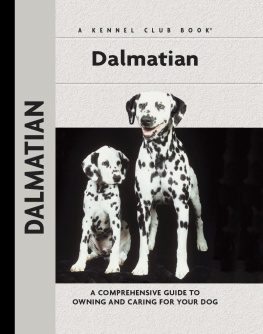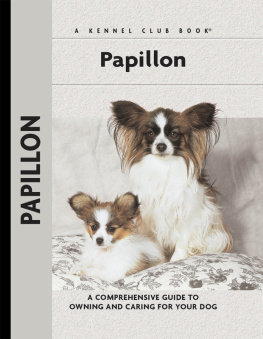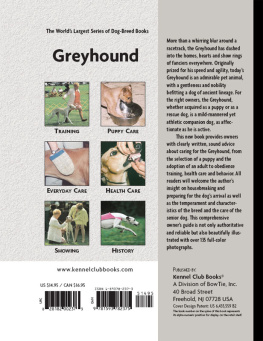Physical Characteristics of the Dalmatian
(from the American Kennel Club breed standard)
Head: The head is in balance with the overall dog. It is of fair length and is free of loose skin. The top of the skull is flat with a slight vertical furrow and is approximately as wide as it is long.
Eyes: Set moderately well apart, are medium sized and somewhat rounded in appearance, and are set well into the skull. Eye color is brown or blue, or any combination thereof.
Nose: Completely pigmented on the leather, black in black-spotted dogs.

Chest: Deep, capacious and of moderate width, having good spring of rib without being barrel shaped.
Forequarters: The shoulders are smoothly muscled and well laid back. The elbows are close to the body. The legs are straight, strong and sturdy in bone.
Ears: Of moderate size, proportionately wide at the base and gradually tapering to a rounded tip. They are set rather high, and are carried close to the head, and are thin and fine in texture.
Neck: Nicely arched, fairly long, free from throatiness, and blends smoothly into the shoulders.
Body: Back level and strong. The loin is short, muscular and slightly arched. The flanks narrow through the loin. The croup is nearly level with the back.
Coat: Short, dense, fine and close fitting. It is neither woolly nor silky. It is sleek, glossy and healthy in appearance.
Size: Desirable height at the withers is between 19 and 23 inches.
Color and Markings: The ground color is pure white. In black-spotted dogs the spots are dense black. Spots are round and well-defined, the more distinct the better.
Tail: A natural extension of the topline. It is strong at the insertion and tapers to the tip, which reaches to the hock. The tail is carried with a slight upward curve but should never curl over the back.
Hindquarters: Powerful, having smooth, yet well defined muscles. The stifle is well bent. The hocks are well let down.
Feet: Round and compact with thick, elastic pads and well arched toes.

Contents

How did the Dalmatian get his spots? Find out as you learn about the breeds ancient beginnings and his various roles as coach dog, firehouse dog and entertainer, to name just a few. Follow the breeds spread in popularity as he becomes a major presence in the show ring and a favorite among pet owners worldwide.

Active, intelligent and intuitive, the Dalmatian is a wonderful pet for an owner who can keep up with his high energy level. Learn about his unique personality, unparalleled versatility, physical characteristics beyond the obvious spots and specific health concerns in the breed.

Learn the requirements of a well-bred Damatian by studying the description of the breed set forth in the American Kennel Club standard. Both show dogs and pets must possess key characteristics as outlined in the breed standard.
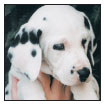
Be advised about choosing a reputable breeder and selecting a healthy, typical puppy. Understand the responsibilities of ownership, including home preparation, acclimatization, the vet and prevention of common puppy problems.
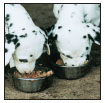
Enter into a sensible discussion of dietary and feeding considerations, exercise, grooming, traveling and identification of your dog. This chapter discusses Dalmatian care for all stages of development.

By Charlotte Schwartz
Be informed about the importance of training your Dalmatian from the basics of housebreaking and understanding the development of a young dog to executing obedience commands (sit, stay, down, etc.).

Discover how to select a qualified vet and care for your dog at all stages of life. Topics include vaccinations, skin problems, dealing with external and internal parasites and common medical and behavioral conditions.

Recognize the signs of an aging dog, both behavioral and medical; implement a senior-care program with your veterinarian and become comfortable with making the final decisions and arrangements for your senior Dalmatian.

Enter the dog show world and find out how dog shows work and how a champion is made. Go beyond the conformation ring to different types of trials and performance events.
K ENNEL C LUB B OOKS D ALMATIAN
ISBN 13: 978-1-59378-225-2
eISBN 13: 978-1-59378-982-4
Copyright 2003 Kennel Club Books An Imprint of I-5 Press A Division of I-5 Publishing, LLC
3 Burroughs, Irvine, CA 92618 USA
Cover Design Patented: US 6,435,559 B2 Printed in South Korea
All rights reserved. No part of this book may be reproduced in any form, by photostat, scanner, microfilm, xerography or any other means, or incorporated into any information retrieval system, electronic or mechanical, without the written permission of the copyright owner.
Photographs by:
Norvia Behling, T. J. Calhoun, Doskocil, Isabelle Franais, Carol Ann Johnson, Mikki Pet Products, Antonio Philippe, Jennifer Porbansky and Alice van Kempen.
Illustrations by Rene Low.

Although the exact origin of the Dalmatian is still uncertain, today it is one of the most distinct-looking and recognizable breeds in the world.

ANCIENT BEGINNINGS
Although it is known that the Dalmatian is a very old breed, its exact origins are somewhat of a mystery. Evidence of Dalmatian-like dogs can be found in artifacts from civilizations as old as ancient Egypt, as drawings of spotted dogs have been found on cave walls and in Egyptian tombs. These early drawings depict the dogs running beside chariots pulled by horses. Some historians maintain that ancient Egypt is, in fact, the birthplace of the Dalmatian breed.
Next page
